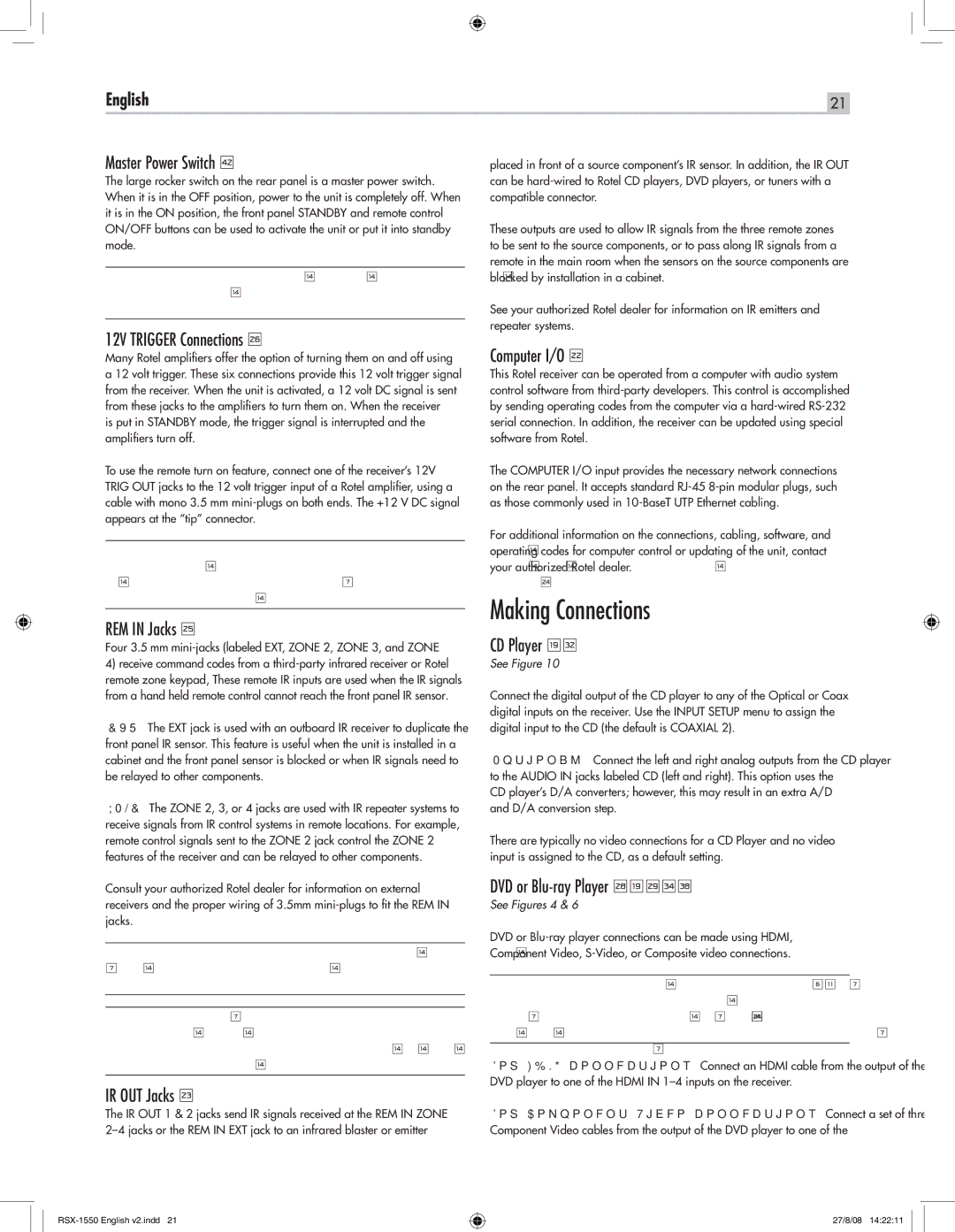
English | 21 |
Master Power Switch n
The large rocker switch on the rear panel is a master power switch. When it is in the OFF position, power to the unit is completely off. When it is in the ON position, the front panel STANDBY and remote control ON/OFF buttons can be used to activate the unit or put it into standby mode.
Note: After all connections are completed, the rear panel master power switch should be put in the ON position and usually left in that position.
12V TRIGGER Connections a
Many Rotel amplifiers offer the option of turning them on and off using a 12 volt trigger. These six connections provide this 12 volt trigger signal from the receiver. When the unit is activated, a 12 volt DC signal is sent from these jacks to the amplifiers to turn them on. When the receiver
is put in STANDBY mode, the trigger signal is interrupted and the amplifiers turn off.
To use the remote turn on feature, connect one of the receiver’s 12V TRIG OUT jacks to the 12 volt trigger input of a Rotel amplifier, using a cable with mono 3.5 mm
Note: The 12V Trigger outputs are configured to turn on in various combinations only when specific input sources are activated. See the INPUT SETUP and ZONE
REM IN Jacks \
Four 3.5 mm
4)receive command codes from a
remote zone keypad, These remote IR inputs are used when the IR signals from a hand held remote control cannot reach the front panel IR sensor.
EXT: The EXT jack is used with an outboard IR receiver to duplicate the front panel IR sensor. This feature is useful when the unit is installed in a cabinet and the front panel sensor is blocked or when IR signals need to be relayed to other components.
ZONE: The ZONE 2, 3, or 4 jacks are used with IR repeater systems to receive signals from IR control systems in remote locations. For example, remote control signals sent to the ZONE 2 jack control the ZONE 2 features of the receiver and can be relayed to other components.
Consult your authorized Rotel dealer for information on external receivers and the proper wiring of 3.5mm
Note: The
Note: The IR signals from the REM IN EXT and REM IN ZONE
IR OUT Jacks [
The IR OUT 1 & 2 jacks send IR signals received at the REM IN ZONE
placed in front of a source component’s IR sensor. In addition, the IR OUT can be
These outputs are used to allow IR signals from the three remote zones to be sent to the source components, or to pass along IR signals from a remote in the main room when the sensors on the source components are blocked by installation in a cabinet.
See your authorized Rotel dealer for information on IR emitters and repeater systems.
Computer I/O p
This Rotel receiver can be operated from a computer with audio system control software from
The COMPUTER I/O input provides the necessary network connections on the rear panel. It accepts standard
For additional information on the connections, cabling, software, and operating codes for computer control or updating of the unit, contact your authorized Rotel dealer.
Making Connections
CD Player uj
See Figure 10
Connect the digital output of the CD player to any of the Optical or Coax digital inputs on the receiver. Use the INPUT SETUP menu to assign the digital input to the CD (the default is COAXIAL 2).
Optional: Connect the left and right analog outputs from the CD player to the AUDIO IN jacks labeled CD (left and right). This option uses the CD player’s D/A converters; however, this may result in an extra A/D and D/A conversion step.
There are typically no video connections for a CD Player and no video input is assigned to the CD, as a default setting.
DVD or Blu-ray Player duflx
See Figures 4 & 6
DVD or
Note: You must use either HDMI or Component Video connections for a progressive scan or high definition player. You must make a Composite Video connection if you want to use the DVD’s signal in one of the three remote zones.
For HDMI connections: Connect an HDMI cable from the output of the DVD player to one of the HDMI IN
For Component Video connections: Connect a set of three Component Video cables from the output of the DVD player to one of the
27/8/08 14:22:11
